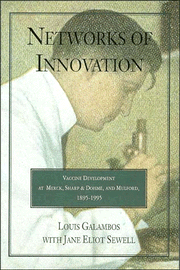Book contents
- Frontmatter
- Contents
- PREFACE
- 1 1894: “The foremost medical question of the day”
- 2 The Mulford Story
- 3 A Sharp & Dohme Interlude
- 4 The Virology Network and a New Program at Merck Sharp & Dohme
- 5 Hilleman's Innovations: First Phase
- 6 Dangerous Interlude
- 7 Transforming Bacteriology: A Second Phase
- 8 New Networks, New Leadership: The Hepatitis B Vaccines
- 9 Vaccine Innovation in the Nineties: New Strategies, New Opportunities, and Public Confrontations
- 10 Historical Perspectives on the Process of Innovation
- ACKNOWLEDGMENTS
- A WORD ABOUT SOURCES
- INDEX
- Plate section
7 - Transforming Bacteriology: A Second Phase
Published online by Cambridge University Press: 06 July 2010
- Frontmatter
- Contents
- PREFACE
- 1 1894: “The foremost medical question of the day”
- 2 The Mulford Story
- 3 A Sharp & Dohme Interlude
- 4 The Virology Network and a New Program at Merck Sharp & Dohme
- 5 Hilleman's Innovations: First Phase
- 6 Dangerous Interlude
- 7 Transforming Bacteriology: A Second Phase
- 8 New Networks, New Leadership: The Hepatitis B Vaccines
- 9 Vaccine Innovation in the Nineties: New Strategies, New Opportunities, and Public Confrontations
- 10 Historical Perspectives on the Process of Innovation
- ACKNOWLEDGMENTS
- A WORD ABOUT SOURCES
- INDEX
- Plate section
Summary
THE LEADER of the Merck Sharp & Dohme Research Laboratories responded forcefully to the negative conclusions of the Vaccine Study – 1979. P. Roy Vagelos was trained as a physician, and although he had spent most of his career in science, he had never abandoned the values of medical practice. Those values were reflected in his response to the vaccine report, and the reasoning was straightforward: Merck's primary mission was to develop effective treatments for human and animal diseases. The best treatment for any disease was prevention. Vaccines prevented disease and Hilleman's organization had for some years now been the most successful in the nation in developing new and important vaccines. They had promising innovations in the pipeline. Without challenging the economic data indicating that Merck should follow several of its former competitors and leave the vaccine business, Vagelos argued strongly that Merck should stay the course. CEO Horan decided to go along with Vagelos – and Hilleman.
There was evidence on both sides of this issue in the work Virus and Cell Biology had been doing recently in developing vaccines for bacterial infections. Hilleman, who had spent his entire adult life working with viruses, had not been eager to transfer his talents and those of his research team into bacteriology. “The point was,” he later recalled, “that if you're doing virology and you have an overwhelming amount of work to do, you don't take on something else.” Max Tishler was persistent, however, and after the great push to complete the measles, mumps, and rubella vaccines was over, Virus and Cell Biology began to explore bacterial vaccines.
- Type
- Chapter
- Information
- Networks of InnovationVaccine Development at Merck, Sharp and Dohme, and Mulford, 1895–1995, pp. 151 - 180Publisher: Cambridge University PressPrint publication year: 1996



